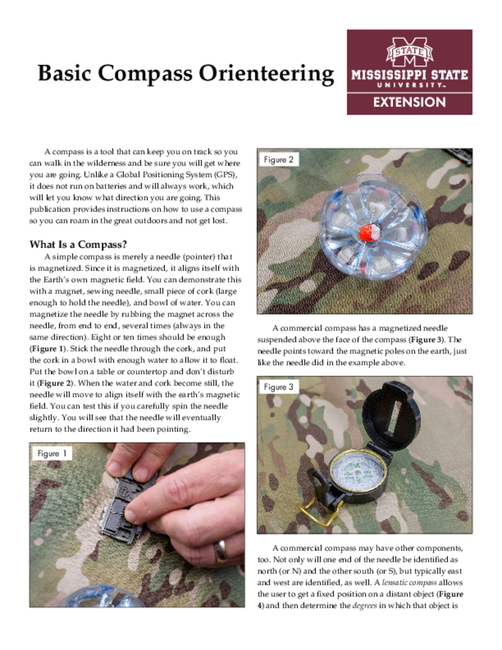Basic Compass Orienteering
A compass is a tool that can keep you on track so you can walk in the wilderness and be sure you will get where you are going. Unlike a Global Positioning System (GPS), it does not run on batteries and will always work, which will let you know what direction you are going. This publication provides instructions on how to use a compass so you can roam in the great outdoors and not get lost.
What Is a Compass?
A simple compass is merely a needle (pointer) that is magnetized. Since it is magnetized, it aligns itself with the Earth’s own magnetic field. You can demonstrate this with a magnet, sewing needle, small piece of cork (large enough to hold the needle), and bowl of water. You can magnetize the needle by rubbing the magnet across the needle, from end to end, several times (always in the same direction). Eight or ten times should be enough (Figure 1). Stick the needle through the cork, and put the cork in a bowl with enough water to allow it to float. Put the bowl on a table or countertop and don’t disturb it (Figure 2). When the water and cork become still, the needle will move to align itself with the earth’s magnetic field. You can test this if you carefully spin the needle slightly. You will see that the needle will eventually return to the direction it had been pointing.
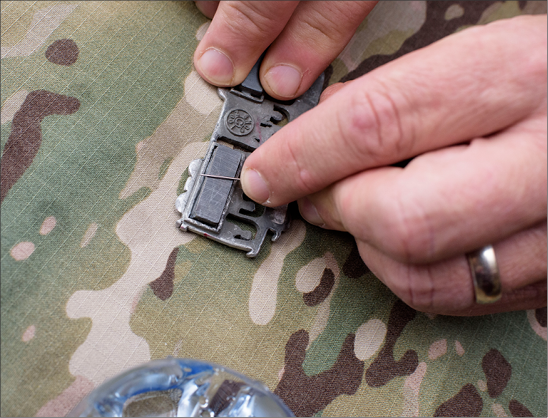
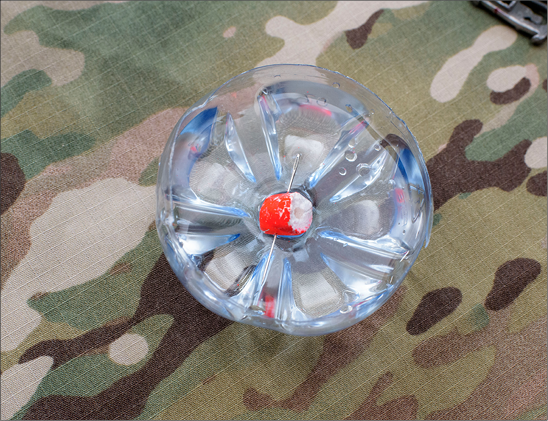
A commercial compass has a magnetized needle suspended above the face of the compass (Figure 3). The needle points toward the magnetic poles on the earth, just like the needle did in the example above.
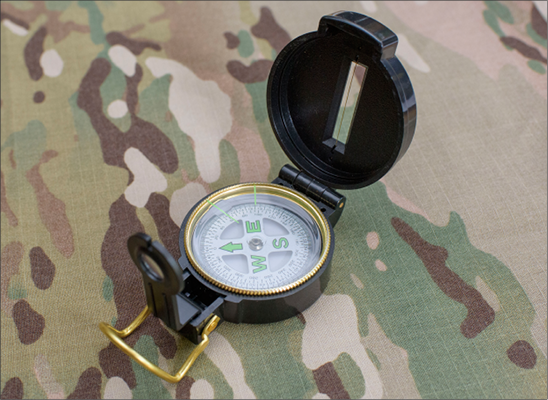
A commercial compass may have other components, too. Not only will one end of the needle be identified as north (or N) and the other south (or S), but typically east and west are identified, as well. A lensatic compass allows the user to get a fixed position on a distant object (Figure 4) and then determine the degrees in which that object is located by using the dial on the face of the compass (Figure 5). This is known as taking an azimuth. Once you have reached one landmark, then you can take another azimuth to the next landmark, repeating the process until you reach your objective.

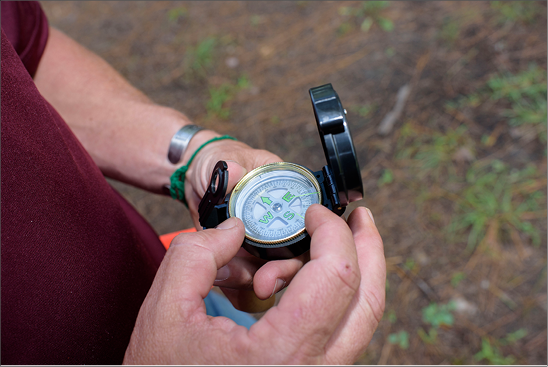
A map compass is more user-friendly with maps. It is mounted on a clear rectangle, and the remaining portion of the rectangle has a small ruler to help you read distances on the map and a magnifying glass to enlarge small landmarks printed on the map (Figure 6).
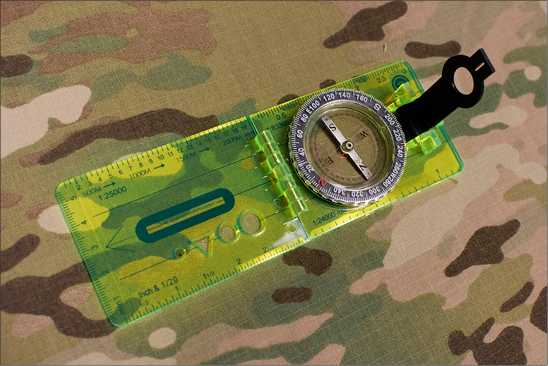
Basic Parts of a Compass
The needle on most compasses is red on one end. The red portion of the needle always points toward magnetic north. It is important to note that any large pieces of metal in the area can affect the compass needle. This means that, if you have a pocket knife in your hand, or you are standing right next a large metal object (such as an automobile), the reading could be off. Looking at the face of the compass, there is another arrow on the base of the dial called the orienteering arrow. This arrow should be aligned with the half of the needle that is pointing north. Remember the rhyme “put red in the shed.” The needle is red, and the orientation arrow is the shed. When the two arrows are aligned correctly, then the compass directions (north, south, east, and west) on the compass will be correct.
The next part of the compass is the bezel. The bezel is divided into degrees, with north being at 0 degrees, east at 90 degrees, south at 180 degrees, and west at 270 degrees. They continue to increase until reaching 360 degrees (due north), when they return to 0. There are smaller divisions between each degree called minutes, and there are 60 minutes in each degree. Only the highest precision compasses will be divided into minutes.
True North versus Magnetic North
True north is exactly what it sounds like: the direction to the North Pole. Magnetic north is the direction to the magnetic north pole. Unfortunately, the true north pole and magnetic north pole are not at the same place, so there is some error when using a magnetic compass to find true north. Many maps will have a correction and explain how to apply it and how that correction changes year to year. Fortunately, in most areas of the United States, the error is small, and the correction is needed only for the most exacting work.
Walking a Course
Navigation in its most basic form is simply seeing a landmark in the distance and walking to it, and then finding another landmark and walking to it. To go back to the original location, you simply follow the landmarks in reverse. Navigators of the past would mark trees with a hatchet to mark a course of travel. While this method still works, most public lands do not allow defacing of trees in this manner. You can mark your course of travel using a compass and a travel log.
For example, if you are walking from landmark A to landmark B, good orientation would mean that you know the compass bearing that takes you from one to another, as well as the distance that you traveled. In a modern GPS, this is known as a track, but, since you are not using a handheld GPS device, you need to create your own travel log. A small notebook and pen can be used to record landmark distances and other comments.
You start by keeping up what is known as a pace count. One pace is two steps; that is, if you start with your right foot, when you put your left foot down, that is one pace. Count each time you put your left foot down and you will have your pace count. For the typical adult, one pace is about 30 inches, but the exact distance will vary for each person. By counting the number of paces it takes you to walk 100 meters and by keeping up with your pace count, you can easily estimate the distance. Sure, your actual pace may vary a bit if you have to step over a rock or something else, but you can correct for that with your counting.
When you are going to be moving over a considerable distance, pacing beads are a very good item to have with you. Pacing beads are just a series of beads on a string (Figure 7). Starting out, the beads need to be on one end of the string. After you have walked 100 meters, move a bead to the other side of the string.

The log page in your journal should look like this:
Route page
|
Azimuth |
Distance |
Notes |
|---|---|---|
|
100 degrees |
0 meters |
camp |
|
250 degrees |
200 meters |
2 beads (large log) |
|
150 degrees |
100 meters |
1 bead (started following creek) |
|
175 degrees |
300 meters |
3 beads (shoreline of lake) |
There will be times when you want to explore around the area of a given azimuth. To do this safely, tie a large, hunter-orange handkerchief in a highly visible area so you will be able to see it over a distance (Figure 8). Never explore beyond sight of the marker when using this method, because you can easily become disoriented.
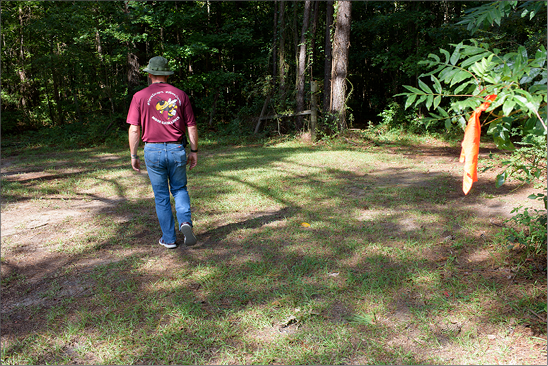
When You Encounter Obstacles
There will be times when obstacles such as a lake or some other terrain feature make it impossible to walk in a straight course. Be sure to mark your starting location (toilet paper is a good visual aid at a distance) and choose a sight reference across the obstacle (such as a tree or rock on the opposite shore). Take an azimuth of this landmark and record it in your log. When you arrive at the landmark, it is equally important to take what is known as a back bearing by taking an azimuth of the toilet paper marker on the other side. This keeps you from drifting from your return course and plots an imaginary line through the obstruction you encountered.
Returning to Camp
When it’s time to return to your starting point, the safest bet in unknown territory is to use the course you plotted. But, if you are familiar with any potential obstacles in your way, you can walk directly back to the original azimuth. This is called a direct route return and is sometimes known as a “panic azimuth,” as it is merely the 180 degree reverse of the starting point azimuth.
Conclusion
Learning to use a compass may seem like a daunting task, but think of it as developing a skill that could save your life and the lives of others. Knowing where you are and how to get back will allow you to fully enjoy the outdoors without the fear of getting lost. Go grab a compass and let the magnetic forces of the earth be your guide!
Publication 3322 (POD-12-19)
By John Long, PhD, Assistant Extension Professor, 4-H Youth Development.
Copyright 2019 by Mississippi State University. All rights reserved. This publication may be copied and distributed without alteration for nonprofit educational purposes provided that credit is given to the Mississippi State University Extension Service.
Produced by Agricultural Communications.
Mississippi State University is an equal opportunity institution. Discrimination in university employment, programs, or activities based on race, color, ethnicity, sex, pregnancy, religion, national origin, disability, age, sexual orientation, genetic information, status as a U.S. veteran, or any other status protected by applicable law is prohibited. Questions about equal opportunity programs or compliance should be directed to the Office of Compliance and Integrity, 56 Morgan Avenue, P.O. 6044, Mississippi State, MS 39762, (662) 325-5839.
Extension Service of Mississippi State University, cooperating with U.S. Department of Agriculture. Published in furtherance of Acts of Congress, May 8 and June 30, 1914. GARY B. JACKSON, Director
